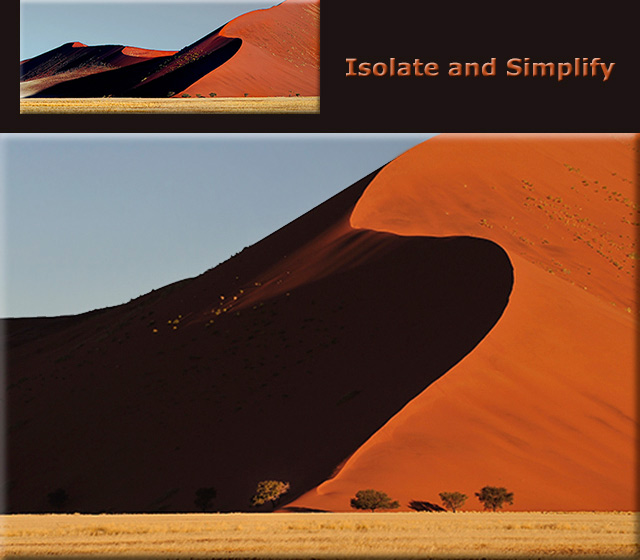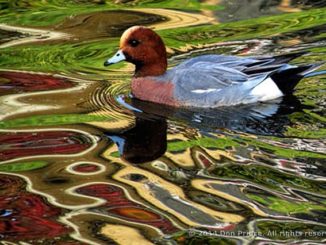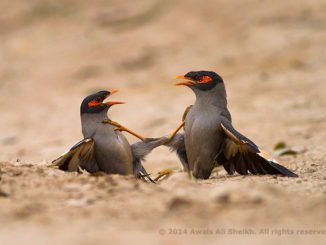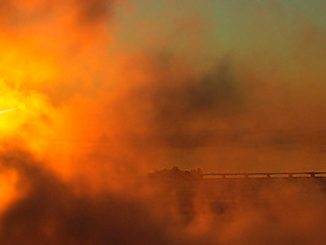Scenic panoramas can indeed be very compelling and beautiful images, but by getting into the habit of slowing down and taking some extra time to examine a scene more closely, one can produce extraordinary photographs.
Dick’s image provided the perfect opportunity for us to share some insight on what that process means for the photographer.
Thinking about the “pieces and parts” of a scene is a good way to begin. Check it out from different angles and vantage points. Think about all the elements of design. Can you extract from the scene specific lines, shapes, forms, values or textures to make your vision into a dynamic composition?
Dick’s started with a huge vista of sand dunes, but he didn’t stop there. He took the time to study the scene and then take it a step further. By isolating, simplifying and eliminating many pieces and parts he distilled the total scene to the point where this super dynamic image evolved. With one simple “S” shaped line, he was able to convey the idea of the entire range of sand dunes.
Red Dunes of Sossuvlie by Dick Jacobs

© 2014 Dick Jacobs. All Rights Reserved.
Subject: Sand dunes on the Namib Desert, Namibia, Africa
Conditions: It was sunset on the Namib Desert and the long shadows began to show the majesty of sand dunes that are constantly being reshaped by winds.
Composition:
1. Bold light and shadow creates flowing S-curve
2. Sense of scale created by low horizon and small trees
3. Strong lines and division of space
4. Isolated and simplified structure in design
5. Intense complimentary colors
Noella’s Comments:
The very first feature that one sees when looking at this image is the beautiful and strong s-curve of the sand dune created by the bold contrasting light and shadow. It dominates the image and creates a path so the eye flows from the bottom to the top and back. There is no way that one can look at this image and move their eye away from the s-curve for very long. As Dick so succinctly put it, “The sculpturing shadows and curves appeared lyrical and musical to me and I tried to capture what I felt and saw with the camera.”
By showing both small and large objects within a scene, one creates a sense of scale. Here the small trees at the base of the dunes convey to the viewer just how huge these sand dunes really are. Without those trees, one would not be able to gauge their size. Add to that the placement of a low horizon line within the image frame and it intensifies the size of the dunes even more.
The image space is divided into four very simple sections: the red side of the sand dune, the dark shadowed side of the dune, the golden foreground, and the patch of sky. By selecting and therefore simplifying the basic structure of the image, Dick made this photograph very strong and dynamic. It is important to note that through his selection of what to include in his image, he eliminated anything that would be a distraction and pull the eye away from that knife-edge between shadow and light.
The complimentary color scheme is bold and intense. Complimentary colors are those that are directly across from one another on the color wheel. Yellow and violet and red and green are complimentary colors, as well as the orange dune and the blue sky that we see in this photo. We don’t always have control over what is presented to us, but as thoughtful photographers, we certainly do have absolute control over what we include and eliminate in our images.
In this photo, Dick was not afraid to make bold use of line, light, shadow and color to emphasize what he was seeing and feeling. Congratulations on an outstanding job and thank you for allowing us to share it with our readers.
Be Included in Our
IMAGE TALK… Series
If you would like one of your images to be considered, please send Noella an e-mail with a low resolution copy of the image. Put “IMAGE TALK” in the subject line and send it to Noella1B@aol.com.




Leave a Reply